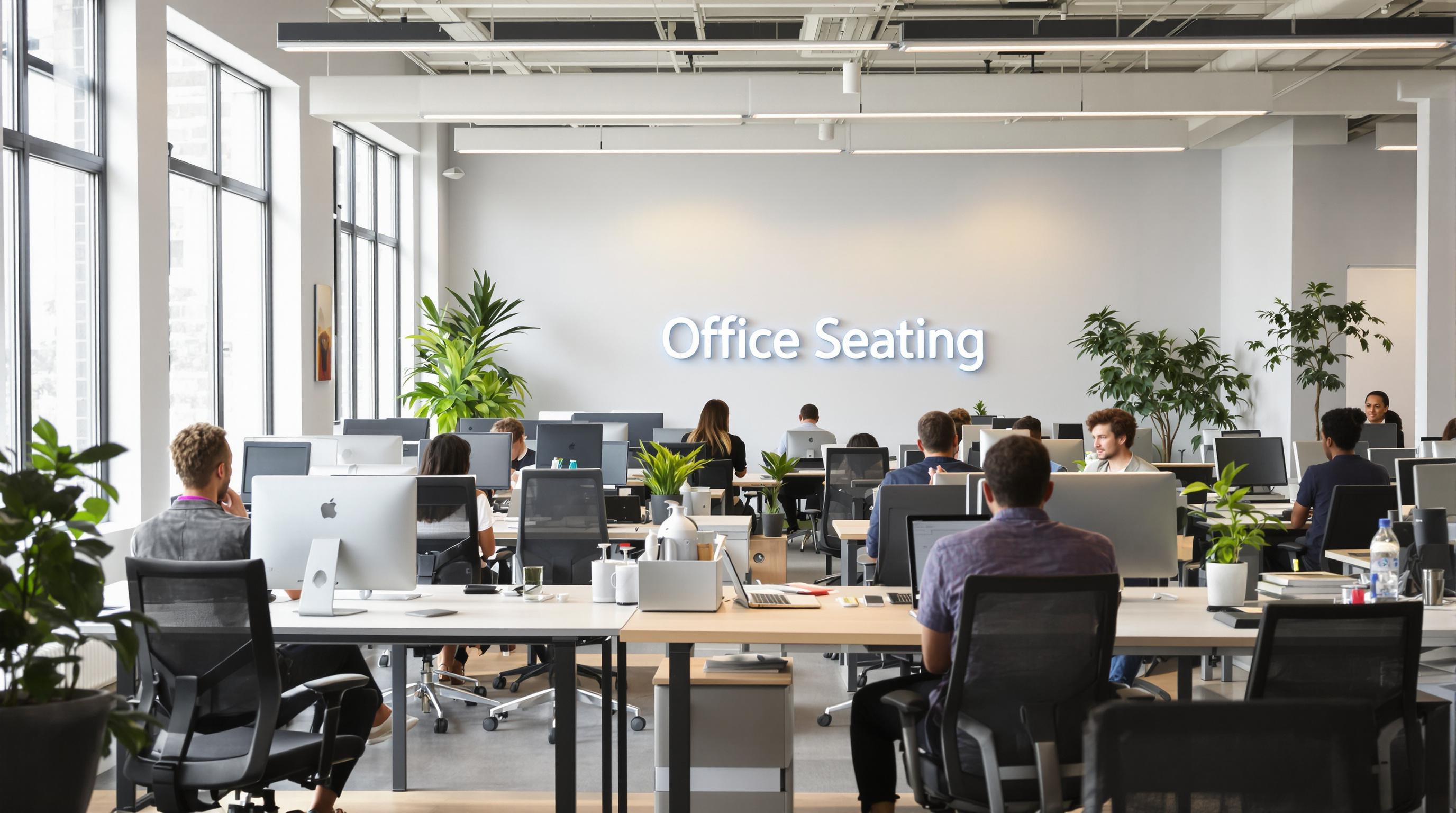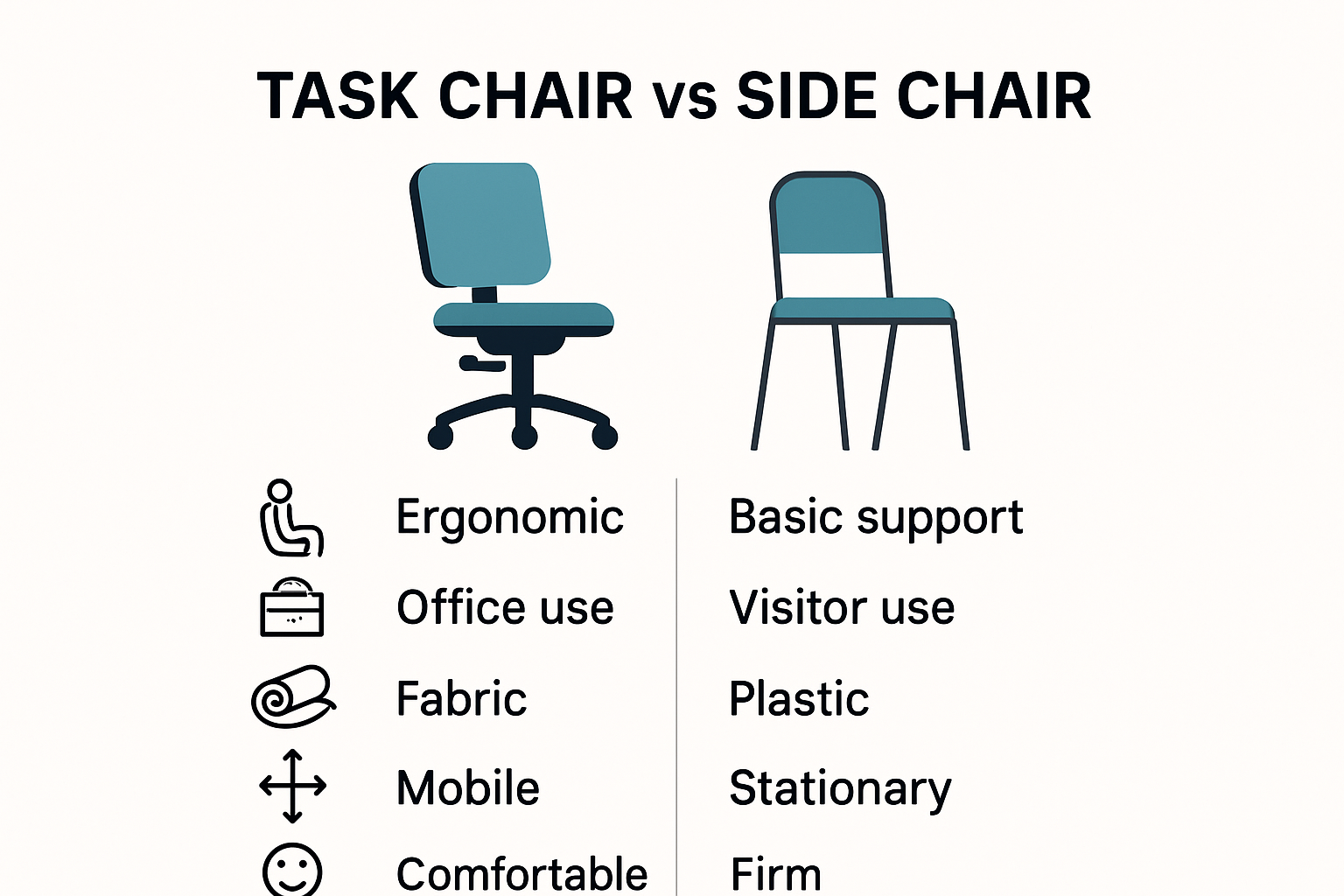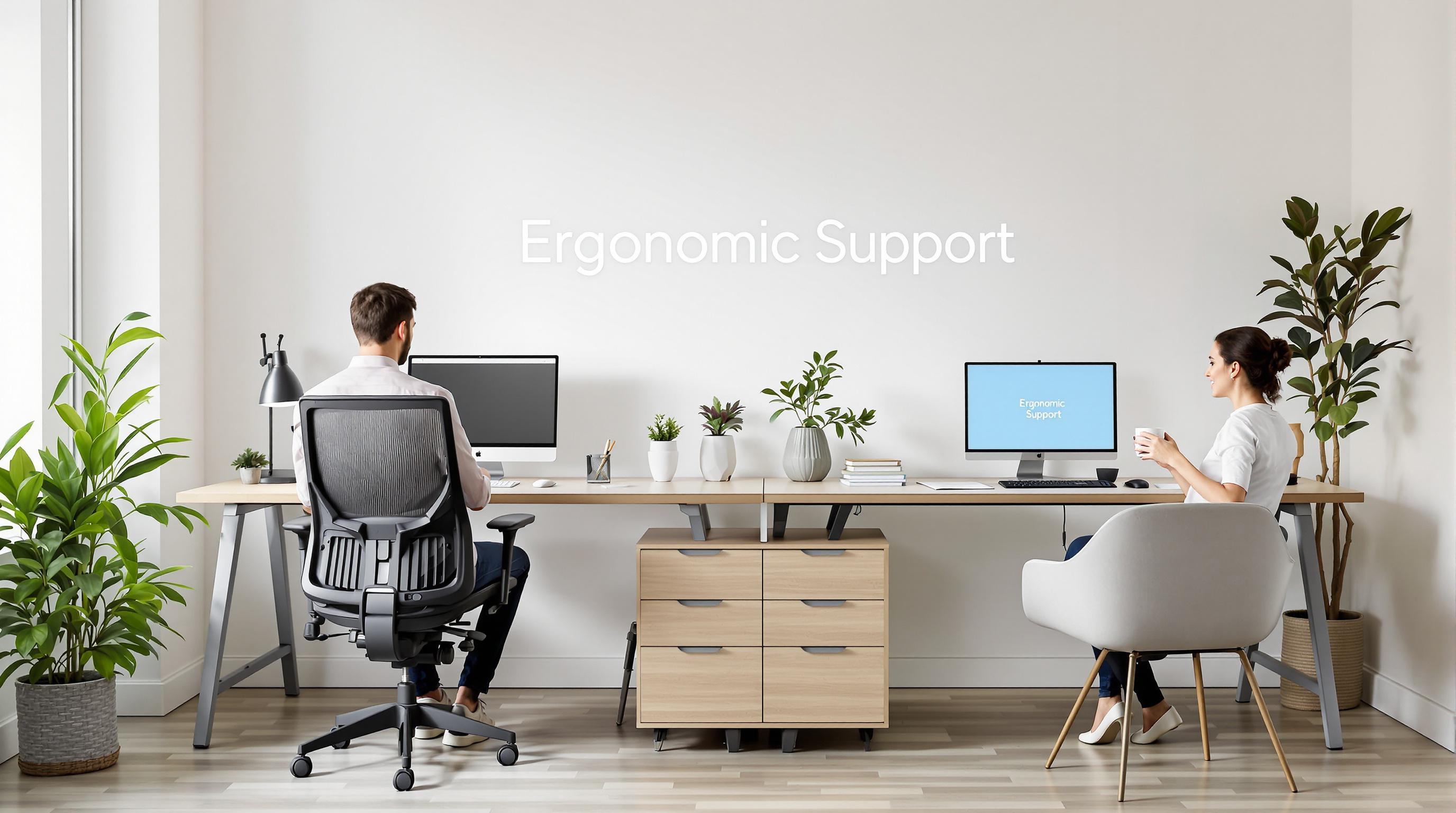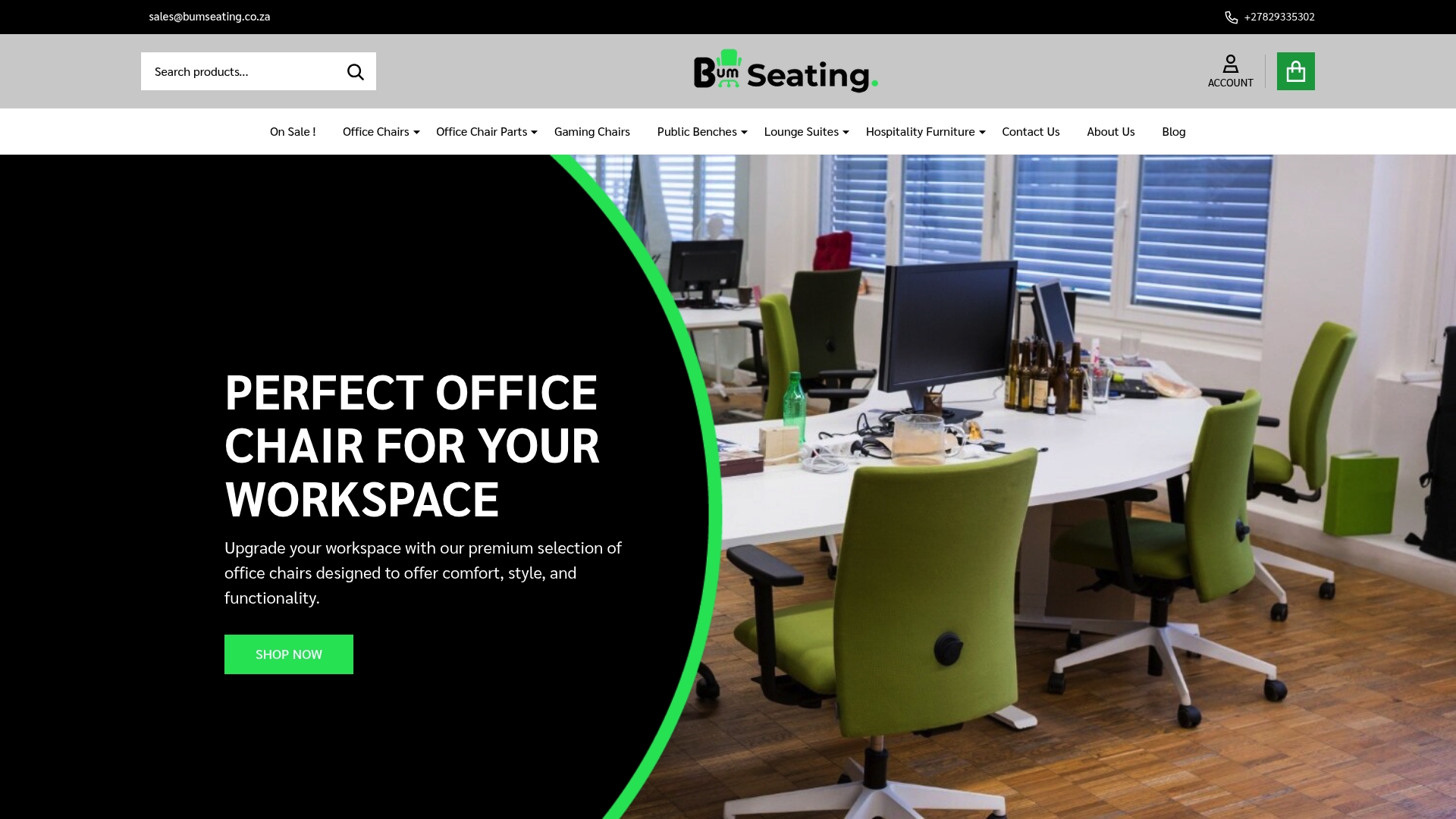Task Chair vs Side Chair: Choosing the Best Seat for Office Spaces 2025
Task Chair vs Side Chair: Choosing the Best Seat for Office Spaces 2025

Office chairs are more important than most people think. On average, South African professionals spend up to 2,000 hours a year sitting at their desks. Here’s the twist. All that time in a chair doesn’t guarantee comfort or productivity. The real surprise is that choosing between a task chair and a side chair could mean the difference between physical strain and lasting workplace wellness.
Table of Contents
- Key Differences Between Task Chair And Side Chair
- Best Uses For Task Chairs And Side Chairs
- Choosing The Right Chair For Your South African Office
- Cost, Comfort, And Style Considerations For Office Seating
Quick Summary
| Takeaway | Explanation |
|---|---|
| Ergonomic Design is Key | Task chairs offer adjustable features designed for long hours of seated work, providing lumbar support, armrests, and height adjustments to reduce strain. |
| Context Matters for Usage | Task chairs are optimal for prolonged individual workstations, whereas side chairs cater to flexible, temporary seating in collaborative or waiting areas. |
| Material Quality Impacts Longevity | Task chairs often use durable, high-performance materials for extensive daily use, while side chairs prioritize lightweight and cost-effective materials suitable for occasional use. |
| Local Considerations are Essential | In South Africa, chair selection should factor in local ergonomics, work culture, varied body types, and office layout specifics to enhance employee well-being. |
| Aesthetics Reflect Company Culture | Office chair selection should harmonize with workplace design and organizational identity, balancing comfort, budget, and stylish appeal for an effective office environment. |
Key Differences Between Task Chair and Side Chair
Choosing the right seating solution for your office space requires understanding the fundamental distinctions between task chairs and side chairs. Bum Seating recognizes that these two chair types serve dramatically different purposes in workplace environments, each designed to meet specific functional and aesthetic requirements.

Ergonomic Design and Functionality
Task chairs represent the pinnacle of workplace comfort and ergonomic engineering. Research from NPS Commercial Furniture reveals that these chairs are meticulously crafted for individuals who spend extended periods seated at desks or workstations. The defining characteristics include adjustable features that promote optimal body positioning and reduce physical strain.
Key ergonomic elements typically found in task chairs include:
- Height adjustment mechanisms that accommodate different user body types
- Lumbar support to maintain proper spinal alignment
- Adjustable armrests that reduce shoulder and neck tension
- Swivel base allowing dynamic movement and easy workspace navigation
In contrast, side chairs prioritize aesthetic versatility over prolonged comfort. Workplace design experts note that these chairs are primarily intended for short-term seating in meeting rooms, reception areas, and collaborative spaces. Their design emphasizes visual appeal and flexible placement rather than individual ergonomic customization.
Intended Usage and Context
The fundamental purpose distinguishing task chairs from side chairs lies in their intended usage context. Task chairs are engineered as primary workstation seating, supporting professionals through long work hours by minimizing physical fatigue and promoting productivity. Their sophisticated mechanisms allow users to make micro-adjustments that maintain comfort during extended periods of sitting.
Side chairs, conversely, serve a more transient function. They are strategically placed in areas requiring occasional seating – conference rooms, waiting areas, or collaborative zones. These chairs prioritize space efficiency, stackability, and visual coherence with surrounding office design. While task chairs might feature complex mechanical systems, side chairs typically offer a more streamlined, lightweight construction.
Material and Construction Considerations
Materials and construction techniques further differentiate these chair types. Task chairs often incorporate high-performance materials like mesh backs for breathability, durable polymers for base structures, and premium upholstery that withstands daily intensive use. Advanced task chairs from Bum Seating integrate cutting-edge ergonomic technologies to support long-term workplace wellness.
Side chairs generally utilize more cost-effective materials optimized for occasional use. Their construction emphasizes lightweight design, ease of movement, and aesthetic versatility. Wood, molded plastics, and simpler fabric coverings are common, reflecting their role as supplementary seating solutions.
Understanding these nuanced differences empowers businesses and individuals to make informed seating selections that align with specific workplace requirements. Whether seeking intensive ergonomic support or flexible aesthetic solutions, recognizing the unique attributes of task chairs and side chairs ensures optimal workspace comfort and functionality.
To further clarify the distinctions between task chairs and side chairs, the following table summarises their key differences across several attributes.
| Feature | Task Chair | Side Chair |
|---|---|---|
| Primary Use | Prolonged, focused workstation seating | Temporary, collaborative, or visitor seating |
| Ergonomics | Highly adjustable, lumbar support, armrests | Minimal or no adjustability |
| Comfort Level | Designed for long-term comfort and posture support | Basic comfort for short-term use |
| Material Quality | Durable, high-performance (mesh, premium upholstery) | Lightweight, cost-effective (plastic, fabric, wood) |
| Mobility | Swivel base, wheels for dynamic movement | Generally stationary or stackable |
| Placement | Individual desks, home offices, dedicated workspaces | Meeting rooms, reception, waiting areas |
| Aesthetic Focus | Functionality with style | Visual versatility and space efficiency |
Call to Action: Explore Bum Seating’s comprehensive range of task and side chairs. Visit our website to discover the perfect seating solution tailored to your unique workplace needs.
Best Uses for Task Chairs and Side Chairs
Understanding the optimal applications for task chairs and side chairs is crucial for creating functional and comfortable workplace environments. Bum Seating recognizes that selecting the right chair for specific contexts can significantly impact productivity, comfort, and overall workspace design.
Professional Workspace Configurations
Task chairs excel in professional settings where individuals spend extended periods performing focused work. Research from the National Institutes of Health emphasizes the importance of ergonomic seating for professionals who spend significant time at their desks. These chairs are ideal for:
- Individual workstations requiring prolonged sitting
- Home office environments
- Computer-intensive roles such as programming, design, and administrative work
- Creative professional spaces demanding extended concentration
The specialized design of task chairs supports long-term physical health by reducing strain and promoting proper posture. Learn more about our advanced seating solutions.

Collaborative and Transitional Spaces
Side chairs serve a fundamentally different purpose in office environments. According to workplace design experts, these chairs are strategically deployed in areas requiring flexible, short-term seating. Optimal uses include:
- Conference and meeting rooms
- Reception areas
- Collaborative workspace zones
- Temporary visitor seating
- Training and educational environments
Unlike task chairs, side chairs prioritize mobility, space efficiency, and aesthetic cohesion. Their lightweight design allows for easy rearrangement and accommodates varying spatial requirements.
Specialized Seating Strategies
Advanced workplace design demands nuanced seating solutions that go beyond traditional chair classifications. Modern offices increasingly recognize the need for adaptive furniture that supports diverse work styles and physical requirements.
For instance, hybrid workspaces might integrate task chairs in dedicated workstations while using side chairs in hot-desking areas or collaborative zones. This approach allows organizations to maximize spatial flexibility and employee comfort.
Bum Seating recommends conducting a comprehensive workplace assessment to determine the most appropriate seating strategy. Factors to consider include work duration, task complexity, individual ergonomic needs, and overall office design philosophy.
Whether outfitting a dynamic startup environment or a traditional corporate office, understanding the distinct capabilities of task chairs and side chairs enables more intelligent workspace design. The right seating solution can transform a mundane office into an environment that promotes productivity, creativity, and employee well-being.
The following table provides a quick overview of the best office settings and scenarios for each type of chair, helping you select the right solution for different areas of your workspace.
| Office Setting/Scenario | Task Chair | Side Chair |
|---|---|---|
| Individual workstations | ✔️ | |
| Home office environments | ✔️ | |
| Conference/meeting rooms | ✔️ | |
| Reception/waiting areas | ✔️ | |
| Visitor/temporary seating | ✔️ | |
| Collaborative/group workspace zones | ✔️ | |
| Computer-intensive/prolonged desk work | ✔️ | |
| Creative/professional studios | ✔️ |
Call to Action: Discover your perfect seating solution. Explore Bum Seating’s comprehensive chair collection and revolutionize your workspace today.
Choosing the Right Chair for Your South African Office
Selecting the ideal seating solution for a South African workplace demands careful consideration of ergonomic design, local work culture, and specific organizational needs. Bum Seating understands that the right chair can dramatically impact productivity, employee health, and overall workplace performance.
Ergonomic Considerations for Local Workspaces
Research from the Occupational Safety and Health Administration highlights critical factors in chair selection that are particularly relevant to South African office environments. Ergonomic features should address the unique challenges of local workspaces, including varied work styles and diverse physical requirements.
Key ergonomic elements to consider include:
- Adjustable seat height to accommodate different body types
- Lumbar support that matches the natural spine curvature
- Breathable materials suitable for warmer South African climates
- Weight capacity that supports a range of body types
The Canadian Centre for Occupational Health and Safety emphasizes that proper chair selection goes beyond mere comfort – it’s a critical investment in employee health and productivity. Learn more about our ergonomic office solutions.
Budget and Workplace Context
Navigating chair selection requires balancing budget constraints with functional requirements. South African businesses must consider multiple factors when investing in office seating:
- Cost-effectiveness without compromising quality
- Durability for long-term use
- Versatility across different office environments
- Maintenance requirements
A study published in Applied Ergonomics suggests that investing in high-quality seating can significantly reduce long-term health costs associated with poor workplace ergonomics. This approach is particularly crucial in South African workplaces where employees may spend extended hours seated.
Local Workplace Considerations
Understanding the unique characteristics of South African work environments is crucial when selecting office chairs. Different industries – from creative sectors to traditional corporate settings – require nuanced seating solutions that reflect their specific operational needs.
Consider the following when making your selection:
- Office layout and space constraints
- Typical work duration and intensity
- Company culture and workspace design
- Individual employee requirements
Bum Seating recommends a comprehensive approach to chair selection. This involves assessing individual workplace needs, conducting ergonomic assessments, and choosing chairs that provide both comfort and functionality.
Remember that the right chair is more than a piece of furniture – it’s an investment in employee well-being, productivity, and organizational success. By carefully considering ergonomic design, local workplace requirements, and individual needs, businesses can create more supportive and efficient work environments.
Call to Action: Transform your workspace with Bum Seating. Explore our comprehensive chair collection and discover the perfect seating solution for your South African office today.
Cost, Comfort, and Style Considerations for Office Seating
Selecting the perfect office chair involves a delicate balance between cost-effectiveness, ergonomic comfort, and aesthetic appeal. Bum Seating understands that modern businesses require seating solutions that not only support employee well-being but also reflect organizational culture and design sensibilities.
Balancing Budget and Quality
Navigating the complex landscape of office seating requires a strategic approach to investment. Research from furniture design experts indicates that businesses must consider long-term value over initial price point. Task chairs and side chairs present different economic considerations:
- Task Chairs: Higher initial investment with potential long-term health and productivity benefits
- Side Chairs: More cost-effective for occasional use and flexible spaces
- Material Quality: Direct correlation between price and durability
- Warranty and Maintenance: Critical factors in overall cost assessment
Companies should view office seating as a strategic investment rather than a mere expense. Explore our budget-friendly seating solutions that combine affordability with exceptional quality.
Ergonomic Comfort and Personal Wellbeing
Comfort transcends mere physical cushioning – it encompasses comprehensive support for individual body mechanics and work styles. Modern office seating must address multiple comfort dimensions:
- Adjustability for personalized ergonomic configuration
- Pressure distribution to reduce physical strain
- Material breathability for temperature regulation
- Weight and posture support
Advanced seating solutions incorporate sophisticated design principles that adapt to individual user requirements. The goal extends beyond basic comfort to proactively support employee health and productivity.
Aesthetic Design and Workplace Identity
Style is no longer a secondary consideration but a critical component of workspace design. Office chairs serve as visual statements that reflect organizational culture, design philosophy, and professional identity. Contemporary businesses recognize that seating choices communicate subtle yet powerful messages about company values.
Consider these style considerations:
- Color coordination with existing office design
- Material selection that complements workspace aesthetics
- Design language matching company brand identity
- Flexibility across different workspace configurations
Bum Seating recommends a holistic approach that integrates functional requirements with aesthetic preferences. The right chair should seamlessly blend performance, comfort, and visual appeal.
Ultimately, selecting office seating is a nuanced decision involving multiple interconnected factors. By carefully evaluating cost, comfort, and style, organizations can create workspace environments that inspire productivity, support employee well-being, and reflect sophisticated design sensibilities.
Call to Action: Transform your workspace with intelligent seating solutions. Discover your perfect chair at Bum Seating and elevate your office environment today.
Frequently Asked Questions
What is the main difference between a task chair and a side chair?
Task chairs are designed for prolonged use at desks with adjustable features for ergonomic support, while side chairs are typically used for temporary seating in collaborative spaces or meetings.
When should I use a task chair versus a side chair in my office?
Use task chairs for individual workstations or roles requiring extended sitting. Side chairs are best for collaborative areas, reception spaces, or as visitor seating where short-term use is expected.
How do ergonomic features impact my choice between a task chair and a side chair?
Ergonomic features like lumbar support, adjustable armrests, and seat height in task chairs enhance comfort and productivity during long work hours, whereas side chairs sacrifice these in favor of mobility and aesthetic versatility for short-term usage.
What materials are commonly used in task chairs and side chairs?
Task chairs often utilize high-performance materials like mesh and durable upholstery for extended wear, while side chairs may use lighter, cost-effective materials such as plastic and wood, focusing on ease of movement and visual appeal.
Unlock Effortless Comfort and Style for Every Office Need
Choosing between a task chair and a side chair is more than just picking a seat. As highlighted in this guide, the stakes are high for South African professionals who spend long hours working and want a healthier, more productive atmosphere. Struggling to separate real comfort from a quick fix? Are you searching for seating that matches both your workspace and work style? Our wide range of seating delivers ergonomic designs, sleek finishes, and practical options to suit any office configuration or budget.

Why settle for discomfort or wasted expense? See how Bum Seating turns insight into action with expertly matched chairs and adaptable products designed for lasting well-being. Take the next step to transform your workspace. Visit Bum Seating now or start exploring our collection of ergonomic and active seating solutions for smarter office choices. Experience the difference and enjoy special deals that reward you for putting comfort first today.
Recommended
- Essential Ergonomic Office Upgrades 2025 for Smart Workspaces - Bum Seating
- Top Statement Seating Ideas for Modern Spaces 2025 - Bum Seating
- Active Seating Solutions for Modern Offices and Homes 2025 - Bum Seating
- Office Chair Repair Basics 2025: Easy Solutions for South Africa - Bum Seating
- Office Chair Types: Key Differences Explained (2025) - Office Furniture Dubai | Buy Modern Office Furniture Dubai - SAGTCO







